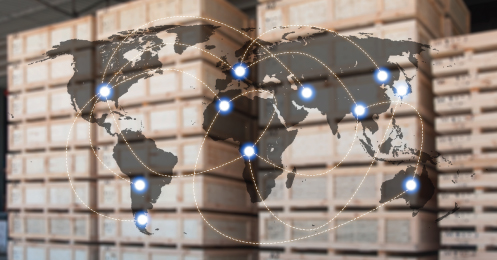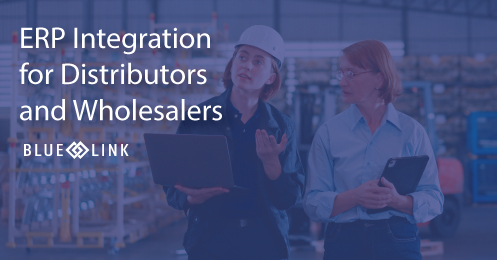For most businesses, the ultimate goal is to increase sales—and there are several ways to achieve that, whether by expanding the product line or adding new sales channels. As a business begins to grow, more distribution opportunities will emerge, and it becomes important to evaluate the best strategies for long-term success. Expanding your distribution business channels to serve a global market can take many forms, including:
- Opening new physical locations
- Partnering with third-party logistics providers (3PLs) in various regions
- Importing products from new suppliers and exporting to new international customers
Whatever the situation, it's important to make sure that you have the proper systems and processes in place for managing the complexities of working with people and businesses from other geographic locations.
The Pros of Global Distribution
Expanding your distribution business globally is a powerful way to boost sales and stay competitive in an increasingly dynamic market. In some industries, large global players dominate such as MRC Global, making it challenging for smaller, family-owned businesses to compete. However, broadening your distribution reach gives you the opportunity to grow your brand, share your unique story, build valuable connections, and ultimately drive more sales. If you're already using an all-in-one ERP system to automate inventory and warehouse management, you’ve got the essential tools in place to support that growth. A global presence also allows your company to diversify risk by minimizing dependence on any single market, and helps you leverage economies of scale, potentially reducing per-unit costs and increasing profitability. Moreover, entering international markets provides exposure to innovative ideas and market demands, which can spur product development and keep your business agile and responsive.
Key Pros:
- Increased sales potential through expanded markets
- Enhanced brand recognition and storytelling opportunities
- Diversification of market risk
- Economies of scale, leading to lower per-unit costs
- Exposure to innovation and new market insights
The Cons of Global Distribution
While global distribution offers immense potential, it also introduces unique challenges. Each target market can differ significantly, and understanding the local consumer preferences, buying habits, and cultural nuances requires substantial research and investment. Operating across multiple time zones inevitably leads to 24-hour sales cycles, increasing demands on customer support teams, logistics, and inventory management, potentially stretching your resources thin. Additionally, complying with varying local regulations and compliance requirements can become complicated and costly, as you navigate diverse customs duties, taxes, product safety standards, labeling guidelines, and trade restrictions. Failing to meet these local compliance standards could not only lead to hefty fines or product seizures but could also negatively impact your brand's reputation. Consequently, businesses must carefully weigh these operational complexities and financial considerations when exploring global distribution opportunities.
Key Cons:
- Varied and complex target market preferences
- Increased operational demands from 24-hour sales cycles
- Complicated local compliance and regulatory requirements
- Risk of fines, penalties, and damaged brand reputation from compliance issues
- Higher investment in research and market entry strategies
Getting Started with Global Distribution
Frequently, global expansion is part of a strategic plan to grow a business which requires an internal review of current operating procedures. Do you have the systems and resources in place to handle this growth? If not, it is time to start evaluating your options.
When it comes to managing growth, a business’ first instinct will often be to hire more employees, but consider implementing more advanced distribution inventory software instead. The right solution can help you grow above and beyond hiring an additional employee and will automate many other tasks across the business. Find a system that provides functionality for managing operations across different geographic locations and has experience working with companies who import and export product.
When looking to expand distribution globally, specific functionality to look for includes:
- The ability to handle multiple currencies
- Landed Cost Tracking
- Managing Different Tax Authorities
- Multi-Lingual options
- Multiple Warehouse Location Management
- eCommerce Integration
- Shipping
- New Partnerships
Multi-Currency
An important aspect to operating on a global scale is the ability to handle multiple currencies. When buying from and selling to different markets, it is important to record transactions using appropriate foreign exchange and to be able to manage multiple currencies for banking and financials. The right system will allow you to set currency defaults by customer and vendor, and convert transactions from the currency in which they took place to your home currency for G/L and reporting purposes. Other important functionality is the ability to perform bank transfers between accounts with different currencies.
Landed Cost Tracking
Landed cost tracking allows you to track the landed cost factors associated with bringing product into inventory, such as shipping, handling, tariffs and import/export fees. Rolling these factors into the actual cost of goods is integral in determining margins and the true cost of inventory. Proper landed cost tracking functionality will allow you to automatically compile all the costs of bringing product into inventory - from within the system - as opposed to having to manually calculate these costs in a spreadsheet and then move the data over. In addition, within the software default landed cost factors can be set based on product SKU and then calculated as a fixed amount or a percentage of the product cost, with the ability to adjust these numbers according to a specific order.
Different Tax Authorities
Even when operating domestically, there will often be multiple tax authorities that will apply when buying and selling product from different regions. A good distribution inventory solution allows you to set these up according to area so that they automatically get applied when buying and selling goods. In certain areas, where tax rates vary significantly from one area ZIP code to another, specific functionality will automatically calculate this information for you based on the location you choose, so that it gets applied properly to every order.
Multi-Lingual
If you’re opening offices in new locations it is important to consider language requirements. Will you have users at different locations accessing the software who speak a different language? If so, consider the implications this can have on your vendor of choice in terms of support, training and user interface. Some vendors may offer a full multi-lingual system and interface, while others may only provide reporting and specific information in a second language. Even if language is not an issue, keep in mind the time difference between your locations and the vendor’s hours of support and how this will affect business.
Multiple Warehouse Locations
If you’re operating a business with multiple warehouse locations there are a couple of considerations to make from a software perspective for example, if you have inventory stored at each location, do you need to transfer and track this inventory movement?
eCommerce Integration
Launching an eCommerce store offers a great opportunity to reach customers worldwide. While many eCommerce platforms can assist with tasks like processing payments and managing user accounts, it’s crucial that your website also connects seamlessly with your back-end distribution and inventory system. Effective eCommerce integration ensures that all data is centralized within your inventory system, allowing information to flow smoothly between your website and internal operations—eliminating the need for duplicate data entry across multiple systems.
Shipping
There are lots of considerations to make when it comes to shipping product around the world, and when buying goods from overseas. Specific functionality to look for includes:
- A system that allows you to track shipments while in transit
- Inventory tracking by individual container
- Re-order point tracking that takes into consideration lead times based on supplier location
New Partnerships
As a business grows, forming strategic partnerships becomes essential to meeting customer expectations—whether in terms of quality, pricing, or delivery. A small distribution company that’s used to handling deliveries directly may need to consider partnering with a Third-Party Logistics Provider (3PL) when expanding into international markets. Additionally, distributors can explore drop shipping options with their suppliers, allowing them to fulfill orders without ever needing to handle or store the products themselves.
The learn about the difference between 3PLs and Drop-Shipping, check out our blog post: Drop Shipping vs 3PL: Ship Products Straight to Customers










